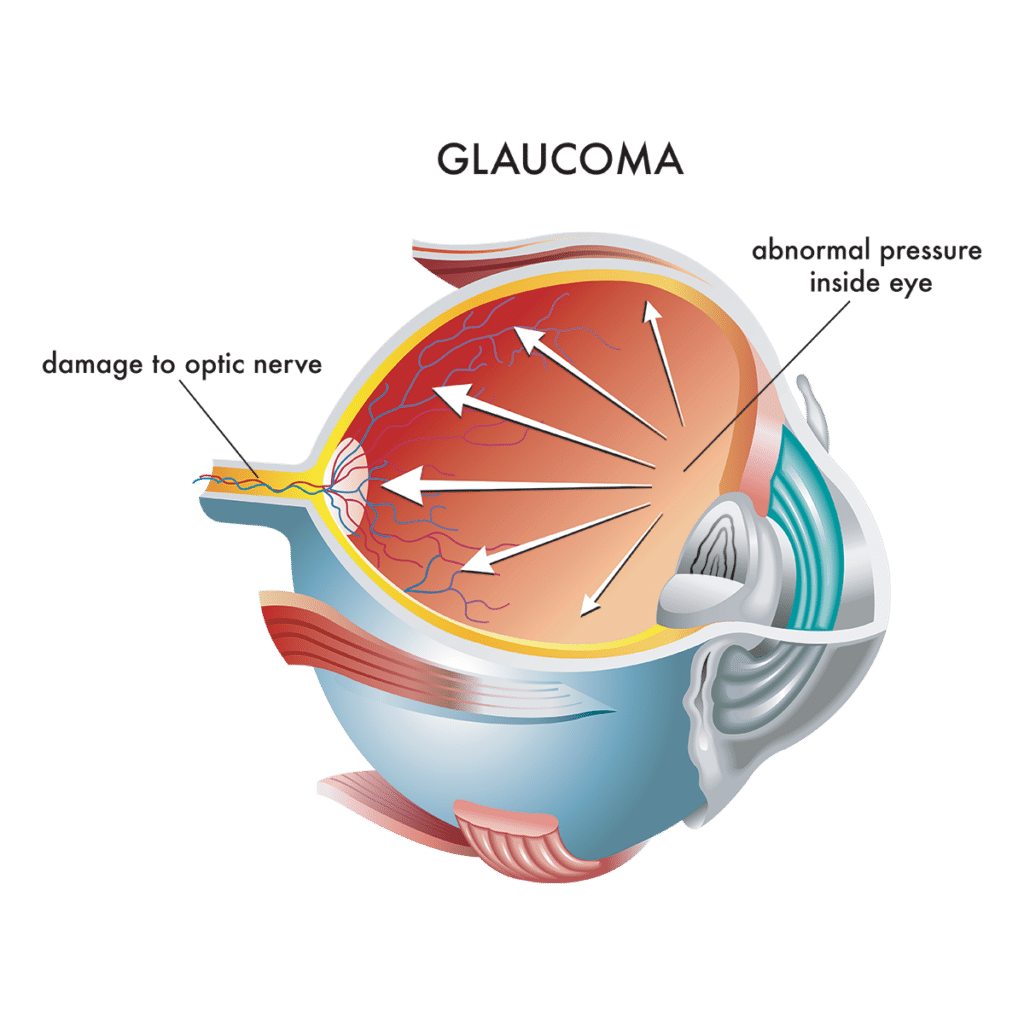Glaucoma
Do you want to learn more about how to preserve your vision? Glaucoma is a common eye condition referred to as “the silent thief of sight”, as it is often undetectable until significant and irreversible vision damage has already occurred. At Wooster Eye Center, we provide comprehensive glaucoma diagnosis and prompt treatment to ensure you can preserve as much of your vision as possible.
What is Glaucoma?
Glaucoma is a serious degenerative eye condition and the leading cause of blindness in people over 60 years old. It is estimated that it affects more than three million Americans.
Glaucoma typically happens due to fluid (aqueous humor) buildup in the front of the eye. In a healthy eye, fluid continuously drains in and out through an area called the drainage angle to maintain stable intraocular (eye) pressure.
If fluid isn’t draining out at the rate it should be, intraocular pressure may rise and damage the optic nerve. Significant damage to the optic nerve can cause irreversible vision loss, meaning detecting glaucoma before damage can occur is the best way to protect your sight.
There are many different types of glaucoma, but the two most common types include:
Open-Angle Glaucoma
Open-angle glaucoma accounts for around 90% of all glaucoma cases. It often occurs slowly as resistance builds up in the drainage angle and raises intraocular pressure.
It often goes unnoticed, as it is typically painless and causes no symptoms at first. In the later stages, patients will likely notice a decrease in their peripheral vision.
Once vision loss occurs, it cannot be restored, so attending regular eye exams with your eye doctor at Wooster Eye Center is essential so they can screen for any early signs of glaucoma.
Angle-Closure Glaucoma
Angle-closure glaucoma is a medical emergency that can occur when the iris blocks the drainage angle of the eye. Acute attacks can cause intraocular pressure to rise very quickly and can result in severe vision damage or blindness if not treated immediately.
If you have acute angle-closure glaucoma, you may experience a sudden onset of symptoms such as:
- Blurry vision
- Nausea and vomiting
- Severe eye pain
- Headache
- Seeing rainbow-colored rings or halos
Although these symptoms can be signs of other conditions, you should seek emergency care immediately to ensure you are correctly diagnosed and treated
Who is at Risk for Developing Glaucoma?
Although anyone can develop glaucoma, certain factors can increase your risk. These factors include:
- Being over the age of 40
- Being of Hispanic, Asian, or African descent
- Having a family history of glaucoma
- Having high eye pressure
- Using long-term steroid medications
- Having diabetes, high blood pressure, or migraines
- Having thin corneas that are thin in the center
- Having had previous eye injuries
- Having had a major eye surgery
- Having a thinning of the optic nerve
- Having refractive errors like farsightedness or nearsightedness
If you are part of any of these high-risk groups, schedule more frequent eye exams with your eye doctor at Wooster Eye Center.

Can Vision Damage from Glaucoma Be Restored?
Once vision damage from glaucoma has occurred, it cannot be restored. Because there are usually no symptoms associated with the condition in the early stages, many patients don’t get treatment until it’s too late.
You can prevent vision loss from glaucoma by attending regular comprehensive eye exams. Your eye doctor may perform a variety of tests to diagnose your condition, including:
- Peripheral vision testing
- Pachymetry, or measuring the thickness of your cornea
- Gonioscopy, or examination of the drainage angle
- Optical coherence tomography (OCT) to look for changes in your optic nerve
- Tonometry, or measuring intraocular pressure
- Performing a visual acuity test
- Photographing your optic nerve
What Treatments Are Available for Glaucoma at Wooster Eye Center?
Depending on how far your glaucoma has progressed, your eye doctor may recommend different treatment options. Glaucoma treatments offered at Wooster Eye Center include:
Do you want to learn more about glaucoma and how you can protect your vision? Schedule an appointment at Wooster Eye Center in Wooster, OH, today.

